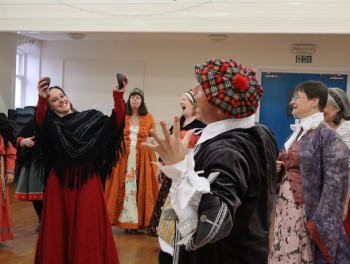THE DANCE AND THE STORY consisted of two activities for adults and children. ROBERT BURNS LEARNS TO DANCE : Storytelling and Historical Dance project for the adult community of Sanquhar, Scotland. Dance was also one of Robert Burns great passion's and influenced many of his songs and poems it is said that he loved to step onto the dance floor. In 1779 he took his first lesson aged 17 yrs in Tarbolton,Aryshire, against the wishes of his father. The project worked with researcher Sue Knight and her published findings of dances that related to Robert Burns. One dance, called Lull thee beyond thee would have been one such dance played on the fiddle by his dance teacher William Gregg. Throughout Burns narrative poem Tam O’ Shanter, we get a very strong sense of the dance and its rhythm as the story unfolds from drinking in the tavern, to the witches in the churchyard. The participants learnt dances from the period, and re-enacted the story with poetry reading and dramatic interpretation.
THE STORY OF THE PRINCESSES OF SCOTLAND : Storytelling and Historical Dance project for the children community of Sanquhar in association with A’The Airts Summer course with Music, Arts and Crafts. Two Scottish Princesses sailed forth across the sea from their native Scotland to France. Margaret Stewart (1424 – 1445) and Mary Queen of Scots (1542 -1587). They both travelled from Scotland to marry a Dauphin at the French Court. Margaret’s dauphin was Louis who would become King Louis XI, but not until after Margaret’s tragic death. Mary married Francis, and enjoyed a year as Queen of France before his untimely death, which meant she had to return to Scotland and suffer turbulent political episodes. Both young princesses had been taught to dance as part of court etiquette in preparation for meeting their princes, and dance was integral to ceremonials and political procedures uniting the Scottish and French courts as the Old Alliance. In particular, the princesses would have danced at their wedding festivities, and Mary would have been taught the history of the earlier princess Margaret Stewart. Margaret had a dance named for her. This dance was a Basse Dance, a dance very popular in other Royal Courts of Europe and referred to in various manuscripts, and danced to display both social status and personal power. The children spent time in the residence learning researched dances, as well as the music, arts and crafts of the time, and created a pageant to tell the story of the journeys of both princesses, featuring imagined versions of the ceremonies that may have taken place.

